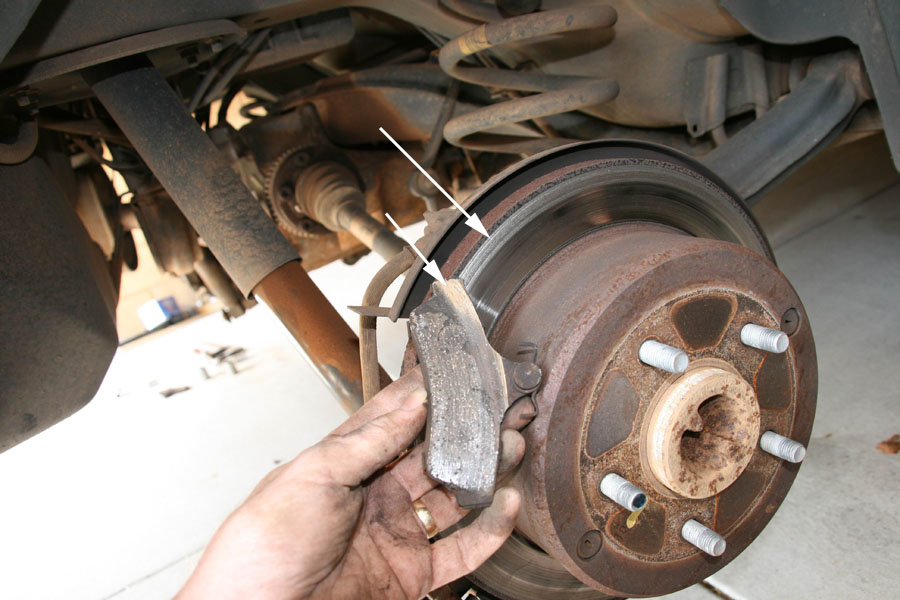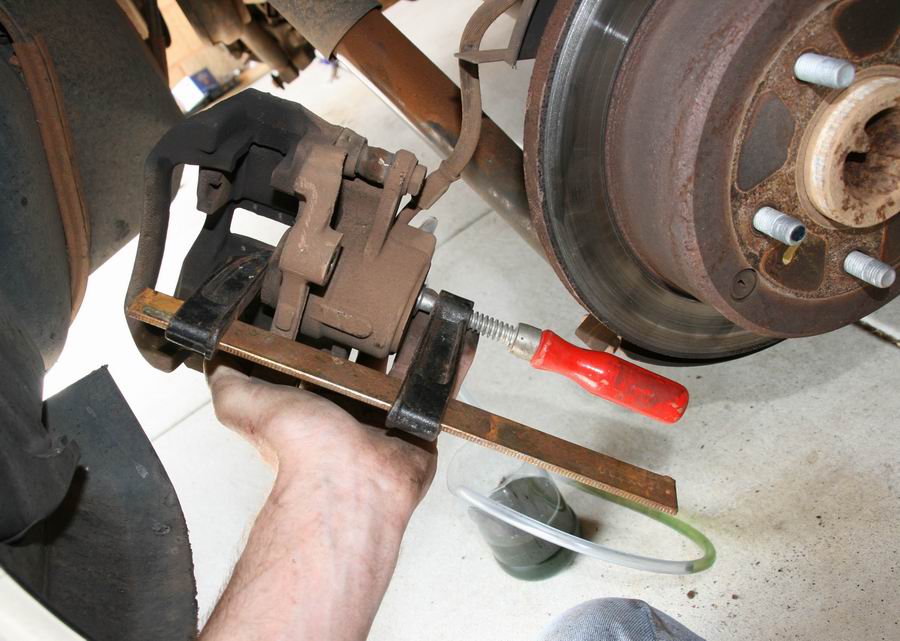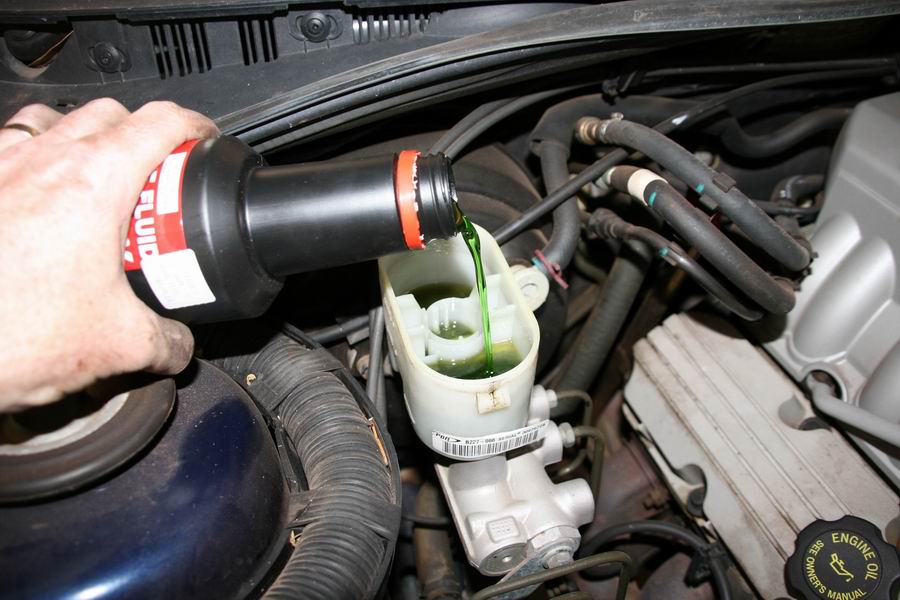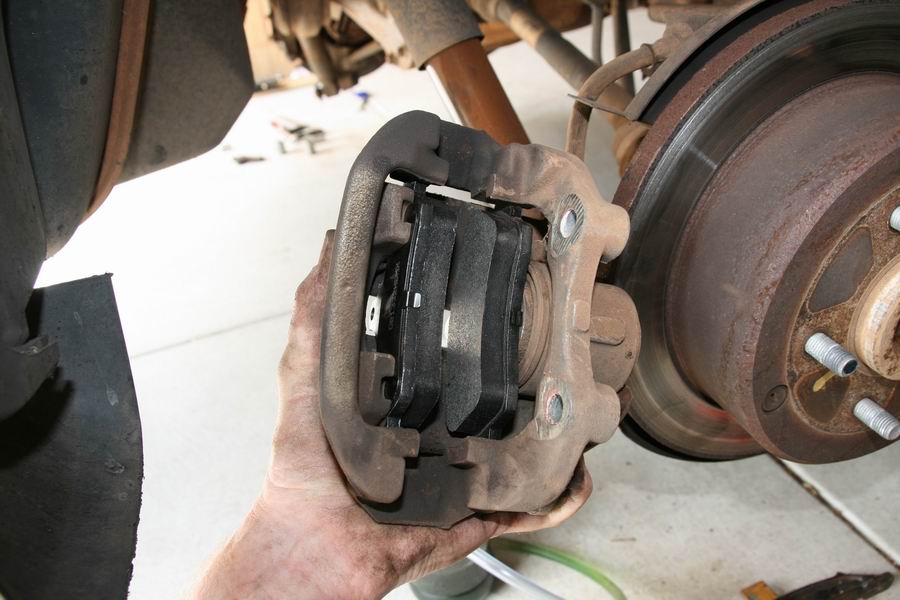If you start hearing terrible grinding noises from your brakes, then the brakes pads have worn through, metal is rubbing on metal, you let it go too far.
With everything else going on in my life, but still with the insistence that nobody is touching my cars but me, yeah, I let it go too far, and this is the result. You can see on the tips of the disk rotor where it looks "dull", and on the corner of the brake pad where it is shiny - that is metal rubbing on metal. Now a purist in a race car who needs every last drop of braking power would whip them off and have them machined. In fact, just changing the pads would be enough for a purist to send 'em off for machining.
But you know what? Chuck a new set of pads on and they will sort that rough surface up just fine. Don't let it go much further than this though, okay?
Since I'd first owned cars I would have changed at least 10 set of brake pads and yet I'd never taken the time to write a story about doing it. It's an easy operation - it's made to be easy, brake pads are designed to wear out and be replaced - but some people might not have ever given it a try! Fear not, I'll talk you through it.
Buy some new brake pads - tell the guy at the auto shop the model, and front or back. Disk brakes like these have two pads per rotor. A good set of pads will set you back $AUD50 (2011) but they will do a good 100,000kms of normal driving. While you are there grab yourself a bottle of brake fluid, 500mL is plenty, and a metre length of 6mm plastic tube. Yeah, you can get fancy brake bleeding apparatus, meh, a bit of tube is fine.
Hoick the car up on stands, pull the wheels off. The calliper is typically held onto the stub by two big bolts from the inside; pop them out and pull the calliper away from the rotor. It is still attached by the hydraulic line, let it hang but be careful not to damage the hydraulic line. You don't need to disconnect it, that just makes your job harder. Sometimes if you are lucky you only need to remove one calliper bolt and loosen the other one, and the calliper can be rotated for access to the pads, you don't need to leave the calliper hanging.
Now since the pads have been worn to the bottom the brake piston has pushed all the way out. You need to push it back in so you can fit those new fat pads in place. Near the hydraulic line connection will be a bleeder - loosen it off say half a turn, and put your plastic pipe on it. If you are *s t r o n g* squeeze the piston back in with your hands. That's too much hard work for my office boy hands so I pop a clamp on to do the job. As you squeeze, fluid will come out the bleeder, no worries, make sure you have a jar or something on the other end of the line!
Look carefully though, some pistons have ratcheting adjusters that expand out that will need to be adjusted in - have a good look at the piston arrangment you have.
Once the piston is all the way in, pop the old brake pads off (you may have had to do that already to fit your clamp in) and pop the new pads in. Put the calliper back into place and tighten the bolts up. Now is a good time to flush some brake fluid through the lines - fluid goes yucky after a while; water ingress, dirt. Take the lid off the brake fluid reservoir under the bonnet, top it up. Push the brake pedal a couple of times - this will push fluid from the master cylinder down the line to the calliper you just changed. Top up the fluid regularly, you don't want it to go too low or air will get in the system and you'll have to bleed it out. Keep watching the bleeder as well, when clean brake fluid is coming through tighten up the bleeder, you're done.
If you accidentally let air get in the system, just pour in lots of fluid and keep pumping until there are no air bubbles coming out the bleeder.
Swap sides, repeat. Easy eh?
Now when you go for a test drive, you'll probably get a brake fail indicator come on - the master cylinder front/back biasing gets messed up when you pump a heap of fluid through it to just one brake slave cylinder, several presses of the brakes will get it back to normal again. It goes without saying, but take it easy the first few presses of the brake pedal on your test drive, don't put yourself in a situation where you have to suddenly brake!
That's all there is to it. The new brake pads will bed into the grooves in the disk pretty quick, and will smooth out that roughed up patch where you let metal go on metal. Okay, it isn't ideal and like I say the purists will poo-poo me, but unless the brake pedal is pulsing (because a rotor is not flat anymore) all that's going to happen is the pads probably won't last as long and the braking performance will be a poofteenth of a percent reduced. And if you do decide to get your rotors machined, check the price of new ones first, you might be surprised!
JAW













 database
database